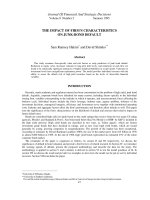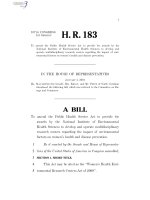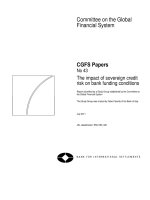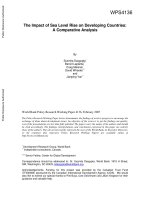The impact of formal political ties on domestic firms exit following competitive foreign entry in transition economies
Bạn đang xem bản rút gọn của tài liệu. Xem và tải ngay bản đầy đủ của tài liệu tại đây (392.11 KB, 171 trang )
THE IMPACT OF FORMAL POLITICAL TIES ON
DOMESTIC FIRMS’ EXIT FOLLOWING
COMPETITIVE FOREIGN ENTRY
IN TRANSITION ECONOMIES
ZHENG WEITING
NATIONAL UNIVERSITY OF SINGAPORE
2008
1
THE IMPACT OF FORMAL POLITICAL TIES ON DOMESTIC
FIRMS’ EXIT FOLLOWING COMPETITIVE FOREIGN ENTRY IN
TRANSITION ECONOMIES
ZHENG WEITING
(B.A. (Hons.), Beijing Int’l Studies University)
A THESIS SUBMITTED FOR
THE DEGREE OF DOCTOR OF PHILOSOPHY
(BUSINESS ADMINISTRATION)
DEPARTMENT OF BUSINESS POLICY
NATIONAL UNIVERSITY OF SINGAPORE
ii
To my parents, who have offered me endless support for all these years
ii
ACKNOWLEDGEMENTS
I would like to express my wholehearted appreciation to Professor
Kulwant Singh for being my supervisor and mentor, and for supporting my
research endeavor during my days as a Ph.D. student at NUS. The training I
received with regard to research and teaching has been the best possible start I
could have had in my academic career. The experience of working with Prof
Singh is a rigorous learning process, and educates me not only to be a
qualified young scholar but to be a person of great personality as well. I
probably can not thank him enough for all the time he spent reading drafts of
my papers trying to help me to figure out what I want to say and formulate
things in such a way that other people besides me can actually understand.
Thanks also to my co-supervisor, Prof Ishtiaq Mahmood, for his support and
guidance, as well as the wonderful learning experience with him.
I am also deeply indebted to the members of my proposal committee:
Prof Andrew Delios, Prof Chi-Nien Chung, and Prof Will Mitchell. They have
provided constructive comments during my thesis time as well as on the
preliminary version of this thesis. My dissertation also benefited from the
comments of Prof Lu Xioahui, Prof Nitin Pangarkar, Prof Xu Hongwei, Prof
Fu Qiang, Prof Kim-Chi Trinh, and Prof Ed Zajac, with whom I had many
pleasant discussions on my study and life. In addition, many thanks to Prof
Tomoo Marukawa for sharing his data on major Chinese TV manufacturers
during early 1990s.
I am grateful to the Asia Research Institute for granting me a
Fieldwork Funding for this study, which is a great support for my data
iii
collection work in China for this dissertation. I am grateful to NUS for
providing me with conference funding, which made it possible for me to
attend both the Academy of Management and the Academy of International
Business annual meetings, where I presented research papers written jointly
with my supervisors.
My special thanks belong to my colleagues in the Ph.D. program,
especially Zhou Yunxia and Ruan Yi, from whom I received most support,
and with whom I spent a lot of my leisure time during the last and probably
the most difficult time of my student life. Also, I had pleasure to study and
work with all my peer friends: Zhu Hongjin, Zhuang Wenyue, Li Gang, Ma
Xufei, Xu Weiwei, Wu Zhonghua, Wang Pengji, Yuan Lin, Zhao Xiuxi, Ajai
Guar, Wu Zhijian, Qian Lihong, and etc. Many of them provided me with
valuable input and great support.
Finally, and foremost, I would like to thank my parents for their
unfailing support and encouragement over all these years. They have been
always there for me, laughing with me on good days and trying to cheer me up
when life is not that easy. For the endless love and support I dedicate my
dissertation to them.
iv
TABLE OF CONTENS
ACKNOWLEDGEMENTS ii
SUMMARY vi
LIST OF FIGURES ix
LIST OF TABLES x
CHAPTER 1 INTRODUCTION 1
1.1 Introduction 1
1.2 Motivation and Conceptual Overview 3
1.3 Overview of Contributions 11
1.4 Organization of Dissertation 12
CHAPTER 2 CORE CONCEPTS AND THEORIES 14
2.1 Market Entry and Incumbent Reaction 14
2.2 Resource-based View 23
2.3 Political Ties 26
2.4 Conclusions of Literature Review 33
CHAPTER 3 PROPOSITIONS & HYPOTHESES 35
3.1 Political Ties and Exit 36
3.2 The Impact of Different Types of Ties 41
3.3 A Dynamic View on Effects of Political Ties 47
3.4 Political Ties across Economic Conditions 50
3.5 Political Ties in Institutional Transition 51
CHAPTER 4 METHODS AND MEASURES 60
4.1 Context and Sample 60
4.2 Data and sample 74
4.3 Variables 76
4.4 Model Specification 86
CHAPTER 5 RESULTS AND DISCUSSIONS 91
5.1 Descriptive Statistics 91
5.2 Political Ties and Exit 92
5.3 Tie Destinations with Varying Resources 95
5.4 The Timing of Impact 98
5.5 Effects of Political Ties across Economic Conditions 100
v
5.6 Political Ties in Institutional Transition 101
5.7 Sensitivity Analysis 102
5.8 Conclusion 104
CHAPTER 6 CONCLUSION AND IMPLICATIONS 106
6.1 A Summary 106
6.2 Theoretical Implications 107
6.3 Managerial Implications 109
6.4 Policy Implications 110
6.5 Limitations and Future Research 110
BIBLIOGRAPHY 113
FIGURES 123
TABLES 133
vi
SUMMARY
I examine the mechanism by which political ties influence domestic
firms’ exit decisions following competitive foreign entry in a transition
economy. Competition through the entry of MNCs in factor and product
markets tends to crowd out domestic firms, whereas the same competitive
pressures and knowledge spillovers can enhance domestic firms’ effectiveness
and performance. Evaluating the strategic reactions and resources influencing
domestic firms can provide better understanding of the impact of foreign entry
on domestic firms.
I focus on domestic firms’ choice to exit as a strategic reaction to
foreign entry. Drawing from the resource-based view, I study how domestic
firms’ likelihood of exit through acquisition or dissolution is influenced by
one important boundary-spanning resource, firms’ political ties. Political ties
are firms’ linkages with a country’s political system, which typically consists
of the government, the parliament or its equivalent legislative and
representative bodies, and political parties. Political ties provide firms with
access to market information, external resources, and power, which can
influence how and when firms react to competitive pressures from MNC entry.
I distinguish between managerial ties, which are firm executives’ current or
prior positional linkages with the political system, and organizational ties,
which refer to organizational level affiliation with political institutions. My
theory development is formed through three clusters of hypotheses. I first
examine the main effects of political ties on firm exit; I then evaluate the
timing issue - when political ties impact firm exit; finally, I examine how the
vii
impact of ties on exit is contingent on environmental factors such as
development of legal effectiveness and market uncertainty. I test my
hypotheses on a sample of 330 firms in the Chinese TV manufacturing
industry over the 1993-2003 period. The Chinese TV industry experienced
substantial foreign entry after it had developed substantially, allowing a
conservative test of how political ties can moderate the impact of foreign entry.
My results show that: (1) political ties significantly influence domestic
firms’ likelihood and timing of exit in the face of foreign competition,
increasing the likelihood of domestic firms being acquired and reducing their
likelihood of dissolution; (2) the origin and destination of political ties
influence their impact, with ties with more proximate origins and those with
greater resources and power having significantly stronger impact on firms’
likelihood of being acquired; political ties that originate with organizations
having more resources also have earlier impact on firms’ likelihood of being
acquired; (3) political ties only influence exit through dissolution in the short
run, suggesting that such ties have a limited life span and do not have a
perpetual impact; and (4) political ties have a stronger effect in environment
with lower macro-economic development and weaker legal effectiveness and
market development, and in environment with higher level of uncertainty,
such that connected firms are more likely to be acquired in less weaker
institutional environment and highly uncertain environments.
By decomposing the concept of political ties and providing detailed
analyses of political ties and firm exit, this dissertation expands and enriches
resource-based view of strategy by further expanding our understanding of
political ties as a resource that can impact firm strategy and outcome. This
viii
study also improves understanding of the impact of domestic firms’ reactions
to the entry of foreign competitors, pushes the research frontier from MNC-
focused paradigm to a new research stream on the other side of the
competition dynamics, the local firms, and provides valuable implications for
firm strategy and policy perspectives.
ix
LIST OF FIGURES
1.1 Research Questions: Domestic Firms’ Reaction to
Foreign Entry
125
3.1 A Summary of Hypotheses
126
4.1 FDI Inflows into China (1979-2004)
127
4.2 Chinese TV Manufacturing Industry, 1993-2004
128
4.3 Foreign Competition in TV Industry, 1993-2003
129
4.4 Industrial Structure of TV Manufacturing
Industry
129
4.5a Smoothed Hazard Rate for “Exit”
130
4.5b Smoothed Hazard Rate for “Exit through
Acquisition”
130
4.5c Smoothed Hazard Rate for “Exit through
Dissolution”
130
4.6 Comparison of Survivor Function
131
5.1 Exit Rates for TV Manufacturing Firms, 1993-
2003
132
x
LIST OF TABLES
4.1 FDI inflows into China (1979-2004)
134
4.2 Brief Review of Chinese TV Manufacturing Industry
135
4.3 Major Foreign TV Manufacturers in China
136
4.4 Total Annual Exits by Year
137
4.5 List of Variables and Definitions
138
5.1 Descriptive Statistics for Complete Sample
141
5.2 Log-logistic Estimates of Political Ties and Firm Exit,
1993-2003
143
5.3 Log-logistic Estimates of Political Ties and Firm Exit
Mode, 1993-2003
144
5.4 Exit and Political Ties at National and Local Levels,
1993-2003
145
5.5 Exit and Political Ties with Different Destination, 1993-
2003
146
5.6a Timing of Effects on Exit through Dissolution, 1993-
2003
147
5.6b Timing of Effects on Exit through Acquisition, 1993-
2003
148
5.6c Summary: Timing of Effects
149
5.7a Political Ties and Firm Exit across Economic Regions
150
5.7b Political Ties and Dissolution Exit across Economic
Regions
151
5.7c Political Ties and Acquisition Exit across Economic
Regions
152
5.8 Market Development, Legal Effectiveness, Political
Ties, and Firm Exit, 1993-2003
153
5.9 Market Uncertainty, Political Ties, and Firm Exit, 1993-
2003
155
5.10 Sensitivity Analysis: Adding Prior Performance
156
xi
5.11 Sensitivity Analysis: Managerial Ties as a Dummy
157
5.12 Summary of Hypotheses Testing
158
1
CHAPTER 1 INTRODUCTION
1.1 Introduction
FDI is an important driver of globalization. In recent years,
governments, particularly those of developing economies, have offered
significant inducements to attract FDI, as it is generally believed that the
primary and spillover effects of FDI boost economic development. However,
it remains less clear how domestic firms are affected by the entry of MNCs.
The entry of foreign firms, which are often equipped with advanced
technological and managerial know-how, increases competitive intensity in
the host country, increasing the likelihood of crowding out some local firms or
negatively affecting their market position. On the other hand, MNCs may also
improve domestic firms through knowledge spillovers, expanding market size,
creating supporting and complementary infrastructure, and improving resource
allocation and utilization (Caves, 1974). Studies of FDI have tended to treat
domestic firms as passive or even unimportant players in the host country, and
have produced inconclusive findings of the impact of FDI on these firms
across different contexts (Chang & Xu, 2006; Li & Shenkar, 1996).
I argue that the impact of multinational corporations’ (MNC) entry on
domestic firms is contingent on domestic firms’ resources and strategic
reactions, and may vary over time as a function of the environment in which
the competitive dynamics are taking place. At the extremes, the entry of
MNCs can eliminate domestic firms, or have no impact on them. The impact
2
of FDI on the domestic economy must consider such possible outcomes.
Failing to consider domestic firms as active incumbent competitors to foreign
entrants prevents a holistic view of FDI’s impact. In addition, the issue of how
domestic firms respond to the entry of MNCs is an inherently important
question, raising issues pertaining to competition and the impact of various
classes of resources on firm strategy and performance.
Many questions thus need to be answered. Do firms react to the entry
of MNCs, and if so, how can domestic firms respond to competitive foreign
entry? Will firms’ resources impact how firms react? What contingencies
affect how firms’ react? In this dissertation, I will focus on domestic firms’
exit decisions as one important strategic reaction towards foreign entry (see
Figure 1.1 for my research question). Calls have been made for examining
value-creating resource beyond firm boundaries (Dyer & Singh, 1998; Gulati,
Nohria & Zaheer, 2000), such as incorporating political components into the
resource-based view (RBV) (Boddewyn & Brewer, 1994). Therefore, aiming
to contributing to both the competition theory and RBV, I attempt to answer
my previous questions by linking firms’ exit with an important boundary-
spanning resource, firms’ connections with political institutions – political ties.
*** Figure 1.1 about here ***
In this dissertation, I examine how formal political ties affect domestic
firms’ exit decisions following competitive foreign entry in a transition
economy. Firm entry and exit are issues underpinning the competitiveness of
market economies, and central to the research of industrial organization and
3
firm strategy. Knowing how domestic firms strategically respond to foreign
entry is an important step to understand the impacts of foreign direct
investment (FDI) on the domestic firms and economy. This is a particularly
important issue in transition economies as domestic firms might be crowded
out and displaced by foreign players, thus impacting the transition process
which typically includes privatization and restructuring (Hu & Jefferson, 2002;
Kosova, 2004). Therefore, it is critical to understand how domestic firms
respond to foreign entry in a transition economy, and what the determining
factors are.
Meanwhile, as a boundary-spanning, value-creating resource, political
ties, i.e. business-government linkages, have not been systematically studied
in this setting. My dissertation focuses on an important type of political ties,
formal political ties. Formal ties are a relative term to informal ties, which
arise from social relationships such as friendship and family ties. By formal
political ties, I refer to firms’ affiliation with and firm executives’ current or
prior positional linkages with the political institutions. My study aims to
explore the relationships between political ties and firm exit following
competitive foreign entry to foster deeper understanding of these issues.
1.2 Motivation and Conceptual Overview
1.2.1 Background and Motivation
How FDI impacts the host country’s economy has long been an
important theme in economic research. A summary conclusion from this
4
research stream is that domestic firms benefit from the entry of MNCs,
although with substantial variation for firms in different host countries. Caves
(1974) suggested three ways through which FDI improves domestic firms’
productivity, by (1) enabling more efficient resource allocation in the focal
industry through competitive pressures; (2) inducing a higher level of
technical efficiency (X-efficiency) in the focal and complementary industries;
and (3) transferring technology to domestic firms.
Recent research (Gorg & Greenaway, 2004) on the impact of FDI
inflow on host economies concludes that positive spillovers from MNCs boost
domestic firms’ productivity through four channels – imitation of production
methods and managerial practices (Das, 1987; Wang & Blomstrom, 1992),
skill and knowledge acquisition by workers (Haacker, 1999; Fosfuri, et al.,
2001), competition for X-efficiency (Wang & Blomstrom, 1992; Glass &
Saggi, 2002), and exports as an indirect gain (Aitken, et al., 1997; Barrios et
al., 2003).
A parallel line of reasoning rooted in Industrial Organization (IO)
economics argues that the entry of MNCs may threaten domestic firms’
position in the market. Increased competition from new entrants threatens an
incumbent’s position in the market as well as its access to resources, which
may in turn affect its survival and profitability (Scherer, 1980). Caves (1996)
agrees that MNCs’ proprietary assets and their cost or revenue-productivity
advantages over domestic firms can drive the latter out of the market, or
marginalize them. Aitken and Harrison (1999) argue that though technology
spillovers may exist, more efficient foreign firms may draw demand from less
efficient domestic firms, forcing them to cut production or crowding them out
5
of the market. Therefore, MNC entry can improve domestic firms’ allocative
and technical efficiency, but increase the threat of market share and
profitability declines.
Empirical work in this area was pioneered by Caves (1974),
Globerman (1979), and Blomstrom (1986). Caves (1974) found a positive
spillover effect at the industry level based on cross-sectional data in 1966.
Following Caves, other studies (e.g. Globerman, 1979; Blomstrom & Persson,
1983; Blomstrom, 1986; Li, Liu & Parker, 2001) consistently found a positive
link between FDI and host country productivity using industry-level data.
Their results show that (short-term) positive FDI spillovers exist in developing
(e.g. Mexico), developed (e.g. Australia and Canada), and transition
economies (e.g. China). All these studies used cross-sectional data and tested
the FDI-local productivity at the industry level, obviating the consideration of
differences in influences across heterogeneous domestic firms.
Studies using firm- and plant-level data, however, reveal a more
complex picture of the FDI-productivity relationship. Some found a positive
effect (e.g. Blomstrom & Harrison, 1999; Djankov & Hoekman, 2000;
Zukowska-Gagelmann, 2000), and others no effect (e.g. Kathuria, 2000;
Harris & Robinson, 2004; Kinoshita, 2001). For instance, studying firms in
Venezuela, Aitken and Harrison (1999) found that foreign investment
negatively affects the productivity of domestically owned plants and the gains
from foreign investment seem to be entirely captured by joint ventures. Using
cross-section data for 1995, Buckley, Clegg and Wang (2002) found that non-
Chinese MNCs generated technological and international market access
spillover benefits for domestic firms, but that overseas Chinese investors did
6
not provide technological spillover benefits; state-owned enterprises received
negative spillover from MNCs whereas collectively-owned firms gained from
foreign entrants. These studies highlight the importance of firm – both MNC
and domestic – heterogeneity.
A review of this literature suggests three possible reasons for the
divergent arguments and findings. First, many studies suffer from a survivor
bias, as they do not evaluate firms that exited after the entry of MNCs.
Therefore, those studies that based their analyses only on survived firms tend
to overestimate the positive effect of foreign entry on domestic firms and
economy. Despite its importance as a distinct and tractable measure of firm
performance (e.g. Barnard, 1947; Mitchell, 1991), firm survival has not been
systematically analyzed in this research setting (Kosova, 2004). Gorg and
Strobl (2000), De Backer and Sleuwaegen (2003), and Kosova (2004) are the
only studies that have analyzed the impact of FDI on firm survival or exit.
Second, prior research has generally not considered the influence of
context on the impact of foreign entry. The evidence for positive foreign
impact such as technology spillover on domestic firms broadly prevails across
developed countries (Keller & Yeaple, 2003; Haskel et al., 2001), whereas
studies in developing countries show rather negative impact from FDI (Aitken
& Harrison, 1999; Kathuria, 2000).
Third, improved understanding of the impact of FDI requires an
evaluation of domestic firms as active competitors to the foreign entrants, as
the outcomes of foreign competition are contingent on the resources and
strategies of domestic players. Theoretically, it is important to study the
impact of MNC entry from the domestic firms’ perspective, to complement the
7
MNC perspective. Child (1994) warns that researchers have failed to link the
MNC’s perspective with studies of domestic firms. Li and Shenkar (1996) also
argues that treating local partners as passive providers of relief for MNCs from
local customers, biases and regulations is one of the major problems in
international business research. Luo (2000), studying Chinese domestic firms’
IJV partner selection behavior, calls for more attention to domestic firms,
especially their strategic behavior, economic rationale, and business policies.
Despite the importance of domestic firms’ strategic motives and reactions in
the MNC-local competitive dynamics, empirical work adopting a domestic
firm’s perspective is scarce, warranting great research opportunity in this field.
1.2.2 An Overview
The central issue in this dissertation is the exit strategies of domestic
firms following competitive foreign entry. The issue is an important one, as
FDI, particularly into emerging economies, continues to be a source of major
economic and business change in host economies. Extensive research on the
benefits of FDI for host country economic growth (e.g. Aitken & Harrison,
1999; Caves, 1974, 1996; Gorg & Greenaway, 2004), has been followed by a
recent stream addressing benefits of FDI on MNCs (e.g. Singh, 2003).
Although many studies have examined the effect of foreign presence, “we
know basically nothing about competition between domestic and foreign
firms” (Kosova, 2004: 3), especially how domestic firms react to the entry of
MNCs. Yet, this reaction is central to the issue of the FDI impacts to the host
economy and the growth of domestic firms. How domestic firms react to
8
competitive foreign entry, and what factors influence their reaction and
subsequent performance outcomes are of paramount importance for firm and
industry development, as well as for policy makers. In order to achieve long-
term growth of the national economy, policy makers need to look closer at
how domestic players are affected by the inflows of FDI, and tailor their FDI
policies to promote the growth of indigenous firms (Huang & Khanna, 2003).
This is a particularly important concern for developing and transition
economies, due to the important role played by MNCs in the technological and
economic development in these countries (e.g. Meyer, 2004). On the other
hand, however, domestic firms in transition economies are often least able to
react to or deal with the entry of MNCs. Accustomed to operations and
competition based on the scale and efficiencies of the domestic standard, firms
in transition economies will face the challenge of competing against large
firms with greater access to resources, markets, and experience. Most of the
empirical studies focused on domestic firms in developed economies,
particularly the U.S., suggesting the need for research in transition economies,
which are attractive FDI host countries and which have domestic firms most
vulnerable to the entry of MNCs. In a transition economy, along with the
liberalization and economic reform process, how domestic firms react to the
MNC entry becomes a particularly interesting and important question for the
industry and national economy development (White & Linden, 2002).
As a response to calls for deeper understanding of firms’ boundary-
spanning relationships (Dyer & Singh, 1998; Gulati, Nohria & Zaheer, 2000)
and the recent surge of interest in business-government interface (Chung,
Mahmood & Mitchell, 2008; Faccio, 2006; Faccio, Masulis and McConnel
9
2006; Siegel, 2007; Peng, Lee & Wang, 2004; Rettberg, 2001), this
dissertation evaluates the role of an important firm resource, formal political
ties, in domestic firms’ choice of exit in response to competitive foreign entry
in transition economies. Formal ties are a relative term to informal ties, which
arise from social relationships such as friendship and family ties. By formal
political ties, I refer to firms’ affiliation with and firm executives’ current or
prior positional linkages with the political institutions. Despite substantial
research effort on firms’ linkages with the government (Peng & Luo, 2000; Li
& Atuahene-Gima, 2001; Xin & Pearce, 1996), little attention was paid to
firms’ actual ties, but rather, managerial perception of ties or efforts used to
cultivate ties, which is hard to capture a holistic view on business-government
interface. It is therefore important to place greater attention on the more
observable ties originating of firms (Faccio, 2006; Faccio, Masulis and
McConnel, 2006; Johnson and Mitton, 2003; Siegel, 2007).
This study draws from several streams of research: the competition
theory, the resource-based view, social capital theory, and political economics.
My central arguments are that: (1) domestic firms’ ties with political
institutions influence their likelihood of exit in response to competitive foreign
entry; I distinguish between two modes of exit, being acquired or dissolution,
(2) ties at different organizational levels (i.e. origins) and linked to different
political agencies (i.e. destinations) are likely to cast different influences on
firm exit and the timing of their impact may vary, (3) political ties may have
different impact on firm exit across different environments, and the effects of
political ties are likely to vary with economic development, institutional
development, and market uncertainty.
10
I explore my hypotheses on a sample of 330 firms in the Chinese TV
manufacturing industry in the 1993 to 2003 period. This is a suitable context,
as the TV manufacturing industry in China experienced the relatively late and
sudden entry of MNCs, permitting my analyses without extensive “left-
censoring”. The Chinese TV industry received substantial foreign investment
during the period of my study, leading to sufficient domestic-foreign
competitive dynamics. The entry of foreign firms in this industry also took
place after the domestic industry had grown and developed to the point of
approaching international standards of design, technological and operating
efficiencies. This allows a focus on the competitive aspects of the foreign-
domestic interaction rather than the technological ones.
The empirical results broadly support my hypotheses. First, both
organizational and managerial ties have significant effects on firm exit,
facilitating firms’ decision to be acquired and preventing them from dissolving.
Second, the origin and destination of political ties influence their impact: ties
with more proximate origins and greater resources and power have
significantly stronger impact on firms’ likelihood of being acquired; political
ties that originate with organizations having more resources also have earlier
impact on firms’ likelihood of being acquired. Moreover, political ties only
influence exit through dissolution in the short run, suggesting that such ties
have a limited life span. Finally, political ties have a stronger effect on exit in
less developed economic and weaker institutional environment, and in more
uncertain environments.
11
1.3 Overview of Contributions
This study makes important theoretical contribution. First and most
important would be my contribution to studies on political ties as a firm
resource. By highlighting that political resources in the form of formal ties
with the political system can be valuable, my dissertation expands and
enriches resource-based view of strategy by “adding a political component that
is largely missing in that literature, which ignores political resources and
competitive methods” (Boddewyn & Brewer, 1994: 135). Next, I decompose
the concept of political ties and conduct detailed analyses on ties at different
levels, and ties with different origins and destinations, which are broadly
missing in the extant literature (Chung, Mahmood and Mitchell, 2008).
Further, from a strategic perspective, I address the foreign-domestic dynamics
from the angle of domestic firms, pushing the research frontiers from
multinational perspective to domestic firm perspective.
This study has important managerial implications by providing insights
into competitive reaction and implications for both domestic and foreign firms.
My study also has implications for FDI policies, competition policies and
regulations to support domestic industries. A policy priority of many
governments is to attract FDI, as it is generally believed that FDIs have the
potential to contribute to the economic development of the host country
through primary and various secondary channels. However, these policies
focused on attracting FDI may not be justified, especially at the firm level and
in developing countries, if the entry of MNCs cause substantial exit of
domestic firms which might undermine the development of the domestic
12
industry. If policy interventions are able to influence the amount of FDI inflow,
it is critical for policy makers to attract FDI while at the same time create an
encouraging environment to promote the growth of domestic firms.
1.4 Organization of Dissertation
In this section, I describe my research background and motivation, and
identify the research question and context for my study. The rest of this
dissertation is organized as follows. In the next chapter, I review the core
concepts and studies that provide the theoretical foundation of my study. In
Chapter 2, I first discuss literatures on market entry and incumbent
competitive reaction, and then go on to examine the mechanism through which
an incumbent’s strategic reactions relate to its resource. I next review the core
concepts in resource-based view (RBV) and respond to prior scholars’ call for
a more systematical analysis on firms’ boundary-spanning resources. Next, I
introduce my key concepts, political ties, and discuss firms’ political ties as a
resource and how this resource will influence firm strategy.
I form my propositions and hypotheses in Chapter 3. This hypothesis
section can be naturally divided into three sections. I discuss the main effects
in the first section. I first propose that a domestic firm’s political ties will
affect the firm’s strategic reaction, such as their choice of exit, distinguishing
exit through dissolution and exit through acquisition. I then discuss in greater
detail how different types of political ties influence domestic firms’ choice of
exit strategy following MNC entry, distinguishing the origin and destination of
ties. The second and third sections discuss contingency factors that are likely









